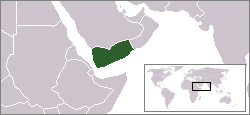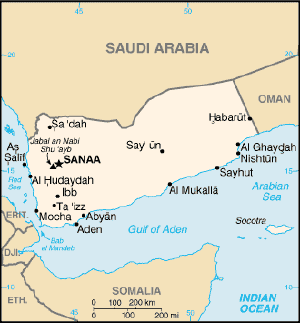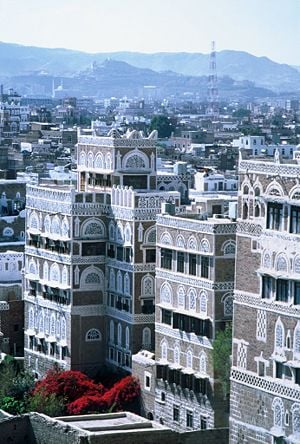Yemen
| الجمهورية اليمنية al-Jumhūrīyah al-Yamanīyah Republic of Yemen |
||||||
|---|---|---|---|---|---|---|
|
||||||
| Motto: الله، الوطن، الثورة، الوحدة (Arabic) "Allah, al-Watan, ath-Thawrah, al-Wahdah" (transliteration) "God, Country, Revolution, Unity" |
||||||
| Anthem: United Republic |
||||||
| Capital (and largest city) | Sana‘a 15°21′N 44°12′E | |||||
| Official languages | Arabic | |||||
| Demonym | Yemeni, Yemenite | |||||
| Government | Unitary Presidential System | |||||
| - | President | Ali Abdullah Saleh | ||||
| - | Prime Minister | Ali Muhammad Mujawar | ||||
| Legislature | Assembly of Representatives | |||||
| Establishment | ||||||
| - | North Yemen independence from the Ottoman Empire | November 1, 1918 | ||||
| - | South Yemen independence from the United Kingdom | November 30, 1967 | ||||
| - | Unification | May 22, 1990 | ||||
| Area | ||||||
| - | Total | 555,000 km² (50th) 203,849 sq mi |
||||
| - | Water (%) | negligible | ||||
| Population | ||||||
| - | 2009 estimate | 23,580,000[1] (51st) | ||||
| - | July 2007 census | 22,230,531 | ||||
| - | Density | 44.7/km² (160th) 115.7/sq mi |
||||
| GDP (PPP) | 2009 estimate | |||||
| - | Total | $58.218 billion[2] | ||||
| - | Per capita | $2,457[2] | ||||
| GDP (nominal) | 2009 estimate | |||||
| - | Total | $25.131 billion[2] | ||||
| - | Per capita | $1,061[2] | ||||
| Currency | Yemeni rial (YER) |
|||||
| Time zone | (UTC+3) | |||||
| Internet TLD | .ye | |||||
| Calling code | [[+967]] | |||||
The Republic of Yemen is a country on the southwestern corner of the Arabian Peninsula, bordering the Arabian Sea and Gulf of Aden on the south and the Red Sea on the west. It borders only two other countries, Oman to the northeast and Saudi Arabia to the north, and its shape bears a resemblance to a forearm lying prone with a raised clenched fist. Yemen's territory includes the remote island of Socotra, about 350 km to the south off the Horn of Africa.
Because the border with the Saudi kingdom is simply a line on the map and not strictly defined as to where in the shifting desert sands it actually runs, the area of Yemen can only be estimated rather than exactly determined. It is somewhere in excess of 500,000 km², making it the second-largest nation on the Arabian Peninsula and about the size of Colorado and Wyoming combined. Yemen's population is close to 21 million, ranking it second again on the peninsula and approaching that of Texas.
The name Yemen is not of certain origin but probably derives from the Arabic word meaning "south," signifying its location on the Arabian Peninsula. Yemen's relative poverty compared to all other nations on the peninsula may partly be due to its having been a country divided in two for the better part of three centuries.
Geography
The landscape of Yemen changes dramatically in the transition from its shorelines toward the great Rub al-Khali desert. The coastal area, often called the "hot land," is a desert-like plain 30 to 40 km wide. Reefs protect the coastline and there are many beautiful beaches.
The most spectacular geographical feature of Yemen is the western mountain slopes. Rising steeply to 2000 m, they are lined with tens of thousands of intricately fashioned terraces. These are part of an age-old but highly sophisticated system of water and soil management that enabled an agriculture-based society to flourish in an otherwise hostile environment. Deep wadis (valleys) divide the mountains and move heavy seasonal rainfall toward the sea. The terraces are used to cultivate coffee and various grain crops.
Farther inland, the central highlands have several large basins, one of which encloses the capital, Sana'a, at an altitude of 2,350 m. They also boast the highest mountain on the peninsula, Nabi Shu'aib (3,650 m). Large-scale agriculture is practiced here, particularly of grapes, grain, fruits, and vegetables.
To the east, the mountains range mostly between 1000 m and 2000 m and are barren and rugged, but agriculture exists in the occasional wadi. In the area where the mountains meet the desert, or Empty Quarter, only grass and shrubs grow and Bedouin graze cattle, but further east, signs of life cease and sand dunes rule the landscape.
The rest of the country, extending to the Omani border, is almost completely desert, with less than 1 percent of the land under cultivation. Vast areas separate a few scattered settlements.
Yemen's easternmost and southernmost points lie on the distant island of Socotra, which lies closer to Somalia than to Yemen and is nearly the size of Rhode Island. Like many remote islands, Socotra has some unique flora and fauna; its name likely derives from a Sanskrit phrase meaning "island of bliss."
Besides the two countries that Yemen borders, it has near neighbors in Djibouti and Eritrea, African nations across the narrow Bab el Mandeb Strait at the southern end of the Red Sea.
History
Ancient kingdoms
Yemen is one of the oldest centers of civilization in the Middle East. Various ancient kingdoms developed between the ninth century B.C.E. and the fifth century C.E. in the rugged valleys between the central highlands and the desert. The famed Queen of Sheba is said to have ruled there, though other locations outside Yemen make the same claim. The source of these kingdoms' wealth and power was the spice trade, which also moved incense and gold overland by camel caravan to Mediterranean markets. The land centering on Yemen was known as Arabia Felix ("Fortunate Arabia") by the Roman Empire, which believed it held fabulous riches. The Romans made an unsuccessful attempt to conquer the area under Augustus Caesar, but later managed to break the Arabian control of the trade routes by finding sources for merchandise farther afield, mainly in India, and using waterways to get to them, which eventually brought the decline of the overland passage.
Arrival of Islam
Ethiopian Christians ruled the area for a short period in the 6th century C.E., but they were expelled by a Persian army that remained in power until the arrival of Islam in 628, the same year Muhammad re-entered Mecca in triumph. The emergence of Islam sparked an unprecedented spiritual revival in the region, profoundly changing and reshaping Yemen. The Persian governor was among the first to embrace Islam. Missionaries sent by Muhammad built Yemen's first mosques. In the next two centuries, Yemenis constituted a large part of the Islamic forces that swept through the Middle East and westward to Spain. They tended to excel as architects, administrators, and merchants even when they settled down far from their homeland.
Distant caliphates ruled over Yemen at times; at other times local Shi’a imamates held sway for centuries. The whole country, as it is known today, seldom remained united since different caliphs and imams often exerted control in the northern and southern areas.
Colonial period
With the European discovery of the sea route around Africa to India, Yemen quickly gained strategic importance to the European powers, first the Portuguese, later the British. The interests of the Europeans frequently clashed with Islamic rulers, including the emerging superpower of the Middle East, the Ottoman Turks, who occupied Yemen for nearly a century, beginning in 1538, until they were expelled.
During this period, Yemen again experienced a prosperous period with the world's discovery of coffee, the cultivation of which some believe began in southern Arabia. Yemen held a global monopoly on coffee production and trade and in time allowed British, Dutch, French, and later American trade missions and factories to be established on the Red Sea coast. Local coffee production declined steeply, though, after the colonial powers established plantations in other locations overseas.
Division into north and south
In 1729, a sultan precipitated the split between northern and southern Yemen that would last 260 years by gaining independence from the ruling imam. In an attempt to secure the trade route to India, the British occupied the port of Aden, overlooking the gulf of the same name, in 1839. This prompted the Turks to safeguard their interests along the Red Sea by retaking the northern part of Yemen in 1848. The border between the two regions of Yemen was fixed by the two powers in 1905.
The Turks withdrew with the collapse of the Ottoman Empire after World War I. The xenophobic imams that succeeded them in the north kept the area in civil war and dodged various assassination attempts even after rebel forces backed by Egypt drove the ruling dynasty into exile in 1962. In the south, centering on Aden, the British initially made peace with the tribes and created a protectorate. But in time, they found themselves fighting multiple liberation groups and hastily withdrew their forces in 1967, leaving power in the hands of a communist front. The resulting people's republic was the only declared communist state in the Arab world, which left it isolated from most other Arab countries.
Unification
Unification of the two republics had been the declared goal of the two Yemens since the beginning. Ideological differences as well as the conflicting interests of Saudi Arabia (which backed the north) and the Soviet Union (which supported the south), however, made such a union seem impossible. A series of border clashes in the 1970s was followed in the 1980s with attempts on paper at unification, but no real developments came about until the collapse of the Iron Curtain in 1989. Before the end of that year, an agreement for a unity constitution was signed. In 1990, the Republic of Yemen was declared, with Sana'a as the capital and the north's President Ali Abdullah Saleh as the new head of state.
Difficulties persisted, however, between the regions of the new country. In 1994, open civil war erupted between north and south, a conflict that was won by the central government, which sent the southern leadership into exile.
In the twenty-first century, Yemen has been in the news mainly with the rise there of fundamentalist Islam, particularly in the south. This glaringly came to the world's attention with the suicide bombing attack on an American navy ship, the USS Cole, in Aden's harbor in 2000 by Al-Qaeda followers.
Economy
Development in a country where virtually no modern structures existed until the 1960s is a formidable task. The British had brought development to the area around Aden, but the rest of the country had no schools, administrative service, local currency or banking system, or health services. Electricity, modern communications, and water and sanitation systems were virtually non-existent. Goods in Yemen were transported on the backs of laborers and animals, and 90 percent of the people were engaged in subsistence agriculture.
The difficult terrain and lack of educated, qualified, and experienced personnel remain the main obstacles to Yemen's development. Hundreds of thousands of Yemenis found low-status employment in Saudi Arabia and the Gulf states during the late 1970s and 1980s. The Gulf War forced the return home of at least 850,000 of them. Remittances from Yemenis working abroad have long contributed heavily to the country's economy. Substantial Yemeni communities exist in many areas of the globe, including the nation's Arab neighbors, Indonesia, India, East Africa, and also the U.K. and the U.S.
The western mountain slopes are the natural habitat of coffee, a crop that probably began its world career in Yemen. Other areas are also agriculturally productive. Large papaya, mango, and banana groves are found in the highland valleys, and citrus and watermelon plantations dot the countryside farther east. Where irrigation is available, dates and cotton grow well in the coastal region.
Yet Yemen imports more than 60 percent of its food, and about one out of five Yemenis suffer from malnutrition. Agriculture employs more than half the labor force, but only about 6 percent of the land is capable of cultivation.
Modest amounts of oil have been found in Yemeni territory since 1984, mainly in the desert east of Sana'a, enough not only to make the country an exporter of the resource but to account for nearly 90 percent of all exports in value. Pipelines run from the oilfields to ports on both the Red Sea and the Gulf of Aden. There are also natural gas reserves believed to be even larger than the oilfields they lie adjacent to.
Demographics
Unlike other people of the Arabian Peninsula who have historically been nomads or semi-nomads, Yemenis outside the cities live in small villages and towns and tend to stay put.
Most Yemenis belong to one of two principal Islamic religious groups: the Shi’a, found in the north and northwest, and the Sunni, who live predominately in the south and southeast. Many minority groups have departed over the decades and centuries, the best known being the "Yemenite Jews" who once formed a sizable community with a distinct culture and long history. Soon after the establishment of Israel, a massive airlift transported practically all Jews in Yemen, nearly 50,000, to their ancestral homeland in 1949 and 1950.
Arabic is the official language, although English is increasingly spoken, particularly in the two main cities. Other Semitic dialects rarely heard elsewhere are spoken in scattered sections of the country. One is Soqotri, the main language spoken on the outlying island of Socotra; it is most closely related to a tongue spoken in a small eastern area of the mainland and another in a remote area of Oman.
Socotra is the one part of Yemen where people of African descent are a majority of the populace. They tend to live near the coastline while those of Arab ancestry reside inland. There are more than 60,000 people living on the island.
Yemen has one of the world's highest birth rates; the average woman bears seven children. Although this is similar to the rates in nearby East Africa, it is roughly twice as high as that of Saudi Arabia and nearly three times higher than those in the more modernized Gulf states. More than half of Yemen's population is under 16 years of age.
Culture
One of Yemen's most prized art forms is the recitation of poetry in classical and colloquial styles. For centuries poetry has been spoken, sung, and also improvised during social events, at special performances, and in competition. Poetry events are also recognized as occasions where topics normally left untouched can be safely broached.
The chewing of khat, or qat, the leaves of a flowering shrub that grows locally, is practically a national pastime among the male population. The use of khat predates that of coffee and is used in similar social contexts. The juices of the leaves bring users slowly to a state of euphoria, stimulation, and sometimes sleeplessness. Khat-chewing sessions can last for hours after meals or in open forums where issues of the day are discussed. In sharp contrast to the opinions of the Saudi clergy, who strictly ban the substance, Yemeni authorities believe that it brings no harm to health or society. Only in Somalia is the use of the leaves more prevalent than in Yemen.
Yemen is basically a poor country, perhaps not as poor as its African neighbors but definitely not as prosperous as its fellow Arab nations. Part of the reason is that a rigid caste-like system rules the Yemeni social hierarchy, especially in areas of work. Those occupying the highest levels can all trace their lineage back to Muhammad. Those in the lower strata are poorly educated and have an indefinite genealogy. They engage in low-status occupations that in most cases are hereditary. Long-term male labor migration within and outside the peninsula has resulted in some changes in the traditional division of labor, since women have had to take over some male tasks, particularly in agriculture.
Notes
- ↑ Population Division of the Department of Economic and Social Affairs of the United Nations Secretariat, World Population Prospects, Table A.1 World Population Prospects: The 2008 Revision. Highlights (New York, NY: United Nations, 2009). Retrieved October 16, 2011.
- ↑ 2.0 2.1 2.2 2.3 International Monetary Fund, Report for Selected Countries and Subjects: Yemen.
Credits
New World Encyclopedia writers and editors rewrote and completed the Wikipedia article in accordance with New World Encyclopedia standards. This article abides by terms of the Creative Commons CC-by-sa 3.0 License (CC-by-sa), which may be used and disseminated with proper attribution. Credit is due under the terms of this license that can reference both the New World Encyclopedia contributors and the selfless volunteer contributors of the Wikimedia Foundation. To cite this article click here for a list of acceptable citing formats.The history of earlier contributions by wikipedians is accessible to researchers here:
The history of this article since it was imported to New World Encyclopedia:
Note: Some restrictions may apply to use of individual images which are separately licensed.




